This
Panzer II version differs in having a different running gear of a
Christie- type suspension and was seen also used as a tracked self-propelled
platform for the 75 mm Pak or 76.2 mm Russian Pak guns, this type
titled “ Marder II”. I was interested in the model for
above reasons as there are not many models around and those I have
are 1/76 scale. (The Flamingo model in 1/76 is on one of the pictures
below for comparison) At the price of these kits, usage of the running
gear to get a 1/72 version of the Marder II but also the Flammpanzer
Flamingo is within reach , so let's have a look at this kit. |
As
all kits in this series, you get a box with nice box art, coupled
to a magazine on Polish defensive battles at beginning of WWII and
German units employing this tank during the conflict.
Also,
as with other kits, you get only one sprue frame with light grey,
semi hard polystyrene parts, containing the whole delivery, enabling
assembly of one unit, the light tank version. The traditional plastic
capsule with glue , a very basic set of decals with early white
cross national emblems and a toothpick for glue application are
also in the box. The magazine, besides the difficult to understand
Polish narrative on the war and events, shows views of the vehicle
, with paint schemes in Vallejo colours and descriptions that, even
in Polish language, can be understood.
There
are also some useful pictures of this type for modellers, as not
so many pictures of the Ausf D are about for reference.
|
 |
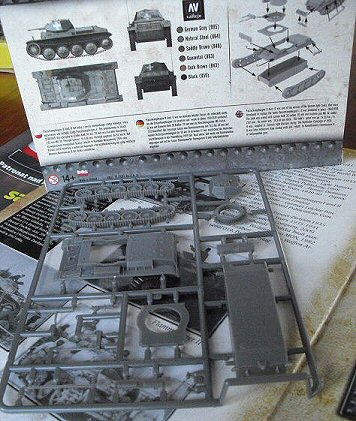 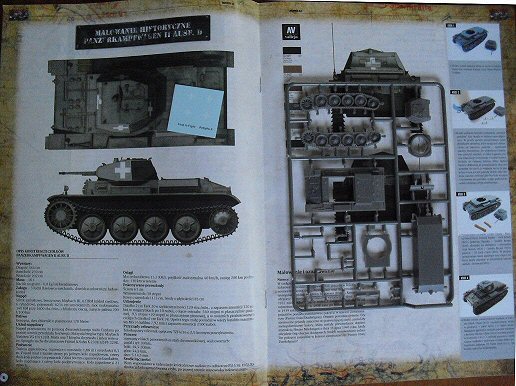
|
The
parts in the sprue look OK and detail is clean, I cannot find moulding
faults like sink marks etc. Panels and such are well rendered and
confirm to my documentation on the type. The anti slip detail on
the mudguards is very nice. Tools are moulded on, but that's to
be expected for a fast assembly kit as this.
Guns
,jack, exhaust ,antennae tray and the like are separate and usage
of a natural piece of wood or stem as a unditching help stowage
is advised. The turret top , guns frontal armour plate and bottom
ring together form a PzKpfw II type turret as used for the Ausf
C, also in this series. This type was actually the same. Looking
at the body, it's a one piece part, to which the two completely
moulded track units are fixed. As explained, these units and the
hull have my interest due to possible use for conversions.
|

|
I
am not disappointed: the company has succeeded in moulding the guide
horns of these one piece track units as a single row and even the
holes in them are clearly visible in profile. If you are not satisfied
highlighting them with paint only, you could open them up (if you
are up to it!).
Outside
track detail, due to moulding limitations, is minimal and consists
of straight bars. Here, a modeller has to help by adding some profile
detail and /or hiding the lack of detail through application of dirt
and debris. There is an option to cut out all wheels and then apply
the separation gap by a saw cut and take away the solid middle of
the sprockets and drive wheels, even adding new tracks or reusing
the "between wheels" pieces after correcting the middle
details as in the past with old Esci M48 and M60 Patton kits, but
that's a show model approach that not many will go for. Personally
I believe clever painting can do the work in a diorama setting and
representative model collection.
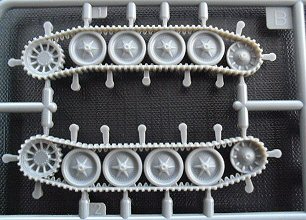 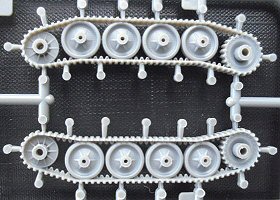
|
Then
the scale issue: on the internet, several different dimensions are
quoted for this Ausf D model, as it seems to have been changed during
its evolution: the general dimensions given for Ausf D are 4.65m long,
2.3m wide and 2.06m height.
But for
the Flamingo (the flame version) it suddenly becomes 4.9m long, width
2.4m meter and height 1.85. This seems to result from using another
engine and adding parts and hull design changes specific for the Flame
thrower. See on the picture right the 1/76 model next to it.
Generally
all the C and F versions dimensions of the other PzKpfw II are given as
4.81m long, 2.1m width and 1.95m high. So we know now that the body
of other PzKpfw II types differs from the D version, namely being
longer and generally only the length and width for the D version needs
to be considered. We also have to bear in mind that there are no survivors
of the early and later versions of D chassis. The ultimate test of
measuring an original can't be done. What's the findings on the FtF
model?
Length comes to 6.2cm and width 3.33cm, measured over the top deck
details including the trackguards and the same for the complete trackunits.
|
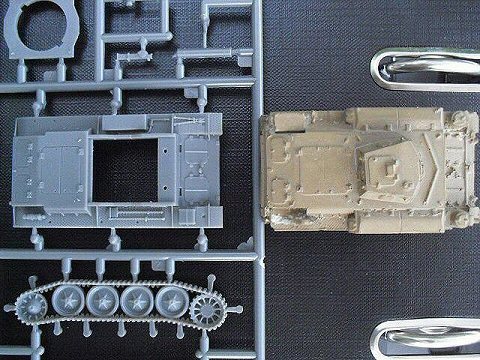 |
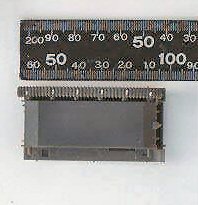 |
A review I read on the net, concluding that this kit is under scale
in length, at first seemed true. However, after gluing on one track
unit, I saw that it protrudes forward (see left) and adds another 2
millimetres in total to the length of the track unit or body to 6.4cm
overall. Even this could be measured longer on a real vehicle when a
protruding tow hook or such would have been there too! The photo tries
to capture that protrusion to the front out of the hull mass.
Translated to our scale length over all should be between 6.4583cm and
6.80555cm given for the D and the Flamingo respectively.
Scale width of body would be 3.1944cm and 3.333cm.
|
Conclusion
Looking
at my findings on the length completed coming to 6.4cm (or more with
a towing pintle) and width 3.33cm, I think this First to Fight kit
is an acceptable 1/72 scale rendition of a seldom seen vehicle, in
a reasonable scale rendition and with the better, single row track
guide horn details and at this price.
I can therefore recommend this kit.
Preview
sample purchased by the author. |